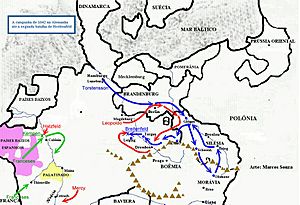Lennart Torstensson facts for kids
Quick facts for kids
Lennart Torstensson
|
|
|---|---|

Lennart Torstensson painted 1648 by unknown artist.
|
|
| Nickname(s) | Blixten (Lightning) |
| Born | 17 August 1603 Forstena, Västergötland, Sweden |
| Died | 7 April 1651 (aged 47) Stockholm, Sweden |
| Allegiance | Sweden |
| Service/ |
Swedish Army |
| Years of service | 1624–1645 |
| Rank | Field marshal |
| Battles/wars | Polish–Swedish War Thirty Years' War Torstenson War |
| Other work | Privy Councillor, Governor-General |
| Signature | |
Lennart Torstensson (born August 17, 1603, died April 7, 1651) was a very important Swedish military leader. He became a Field Marshal, which is a top army rank. He was also a skilled military engineer, someone who designs and builds military structures.
Contents
Early Life and Beginnings
Lennart Torstensson was born in Västergötland, Sweden, in 1603. His parents were Märta Nilsdotter Posse and Torsten Lennartsson. His father supported King Sigismund, who was no longer king. Because of this, Lennart's parents had to leave Sweden when he was born.
Lennart was raised by his relatives. His father returned to Sweden when Lennart was about twenty years old. Lennart's uncle, Anders Lennartsson, was a high-ranking official. He was trusted by Duke Charles, but he died in battle in 1605.
Joining the Military
When Lennart was fifteen, he became a page for the young King Gustavus Adolphus. A page was like a personal assistant. This allowed him to see the Livonian War up close. He watched the capture of Riga in 1621.
At age twenty, he traveled to learn about other countries. In 1626, he fought in the battle of Wallhof. He also served in military campaigns in Prussia in 1628 and 1629.
A General in the Making
There is a famous story about Lennart Torstensson. During one battle, King Gustavus Adolphus sent him with an order for an officer. On his way, Lennart saw that the enemy had moved. He realized the King's order needed to change. So, he bravely changed the orders himself.
When Lennart returned, he told the King what he had done. The King was first angry and raised his hand. But then he changed his mind and said, "Lennart, this could have cost you your life. But maybe you are better suited to be a general than a page."
Soon after, in 1629, Torstensson was put in charge of the Swedish artillery. Artillery means large guns and cannons. Under his leadership, the artillery helped Sweden win big battles. These included the Battle of Breitenfeld and the Battle of Lech.
In the same year, he was captured by the enemy at Alte Veste. He was held prisoner for almost a year in Ingolstadt. After he was released, he continued to serve in the army. He fought bravely in the Battle of Wittstock. He also helped defend Swedish Pomerania in 1637 and 1638. He fought in the Battle of Chemnitz and a raid into Bohemia in 1639.
Lennart became ill during his time as a prisoner. This illness made him return to Sweden in 1641. There, he became a member of the Privy Council. This was a group of important advisors to the King.
Becoming a Field Marshal
In May 1641, the Swedish army's leader, Johan Banér, died suddenly. Lennart Torstensson was called back to Germany to take his place. He became the top commander of the Swedish forces. He was also made the Governor General of Swedish Pomerania. At the same time, he was promoted to the highest rank: Field Marshal.
In 1642, he led his army through Brandenburg and Silesia into Moravia. He captured important fortresses like Głogów and Olomouc. On his way back through Saxony, he defeated the enemy army. This happened at the second Battle of Breitenfeld on October 23, 1642.
In 1643, Torstensson invaded Moravia again. But he was suddenly called to invade Denmark. His quick and unexpected attack surprised the Danish army. This made it hard for Denmark to defend itself on land.
In 1644, he led his army into Germany for the third time. He defeated the enemy at the battle of Jüterbog on December 3. In January 1645, he entered Bohemia. He destroyed the Imperial army at the Battle of Jankau on March 6, 1645. This victory opened the way to Vienna, the capital of the Habsburgs.
He reached Korneuburg, near Vienna, in April. But his army was tired and could not go further. They lost many soldiers trying to capture Brünn in Moravia. After this, the Swedish commander marched towards Vienna again. But on September 25, he turned back to northwestern Bohemia.
On December 23, 1645, Torstensson had to give up his command. He suffered from gout, a painful illness. He returned to Sweden in the summer of 1646.
Later Life and Legacy
In 1647, Lennart Torstensson was given the title of count. From 1648 to 1651, he was the Governor-General of all the western provinces of Sweden. He died in Stockholm on April 7, 1651. He was buried in the Riddarholm Church, a famous burial place for Swedish royalty and heroes.
His Military Skills
Torstensson was known for how quickly he moved his army. This made his movements hard for the enemy to predict. Even when he was very sick, he would lead the army from a special carrying chair. He often could not ride his horse. He was considered one of the best artillery officers and engineers in the Swedish army.
Family Life
In 1633, Torstensson married Baroness Beata De la Gardie (1612–1680). Her father, Johan De la Gardie, was also an important advisor. Lennart and Beata had a son named Anders Torstenson. Anders also became a Privy Councillor and Governor-General of Estonia.
After Lennart Torstensson died, his wife Beata De la Gardie married Per Brahe the Younger in 1653.
See also
 In Spanish: Lennart Torstenson para niños
In Spanish: Lennart Torstenson para niños


